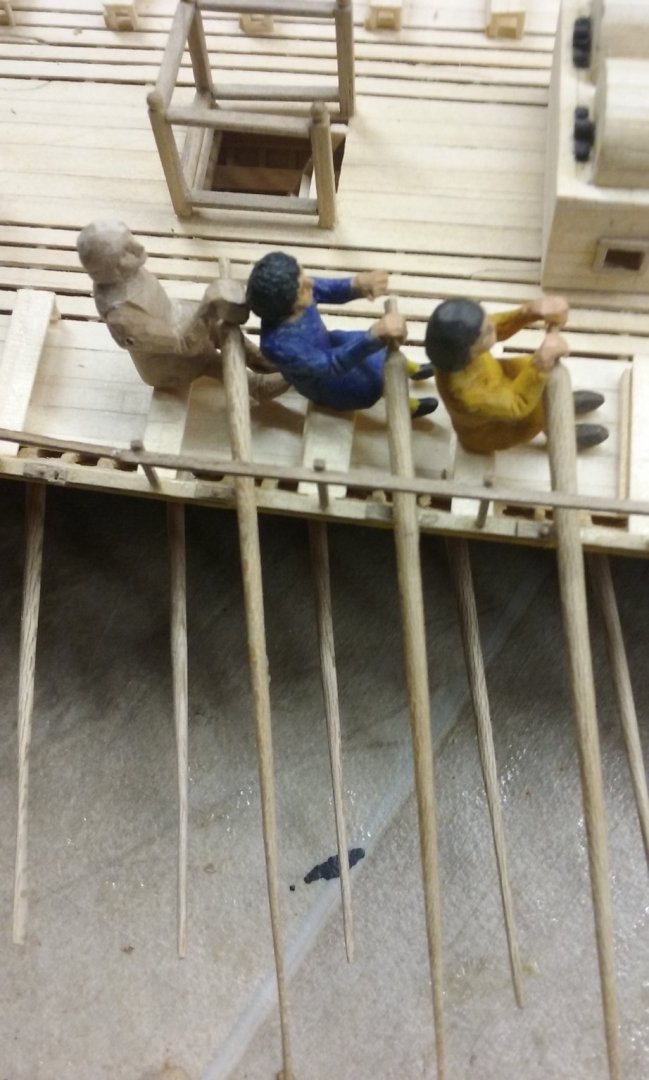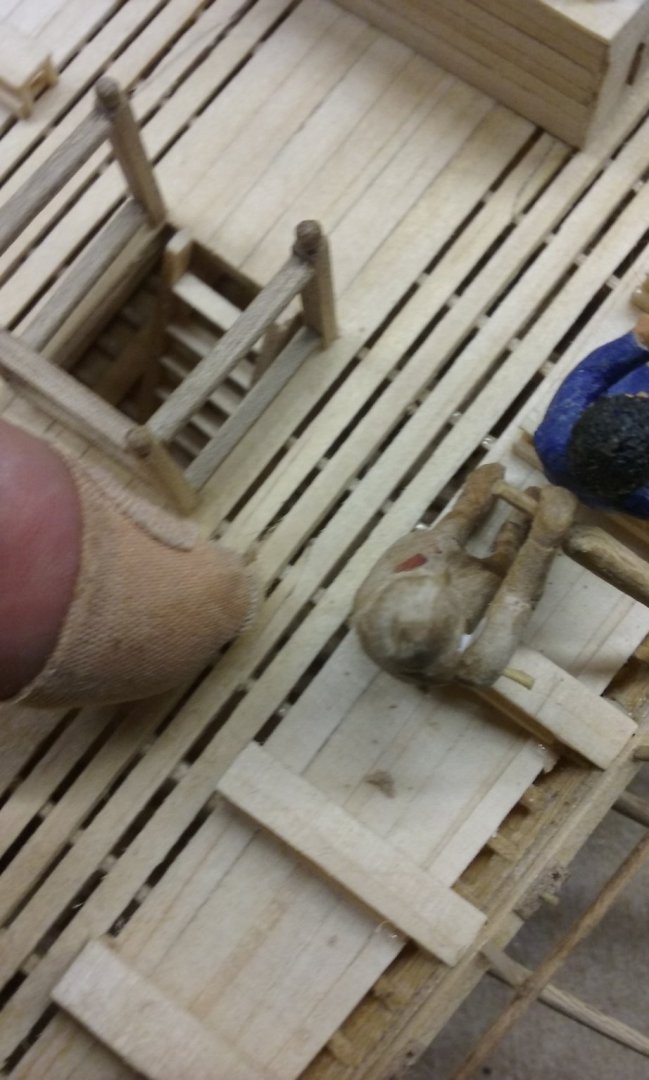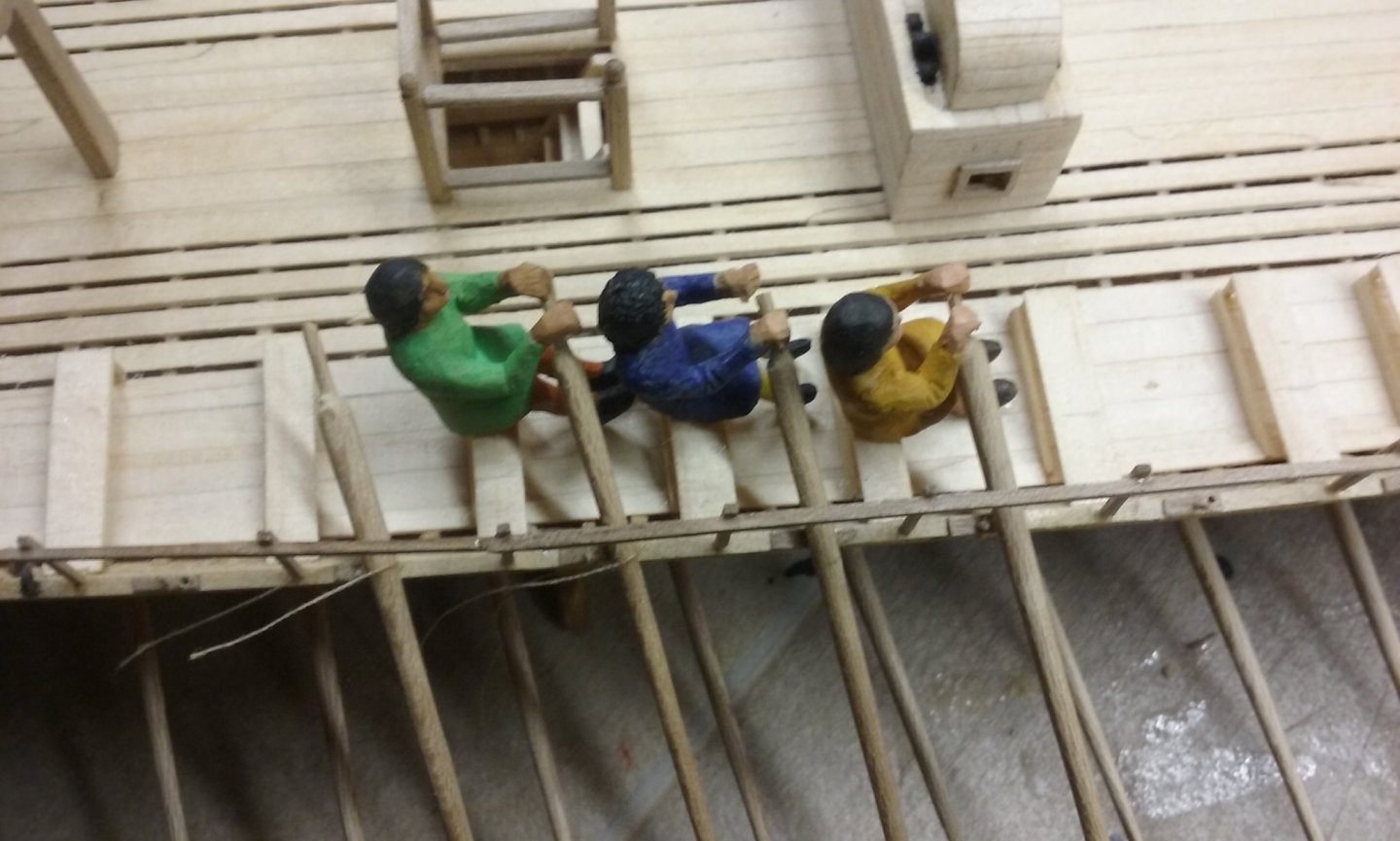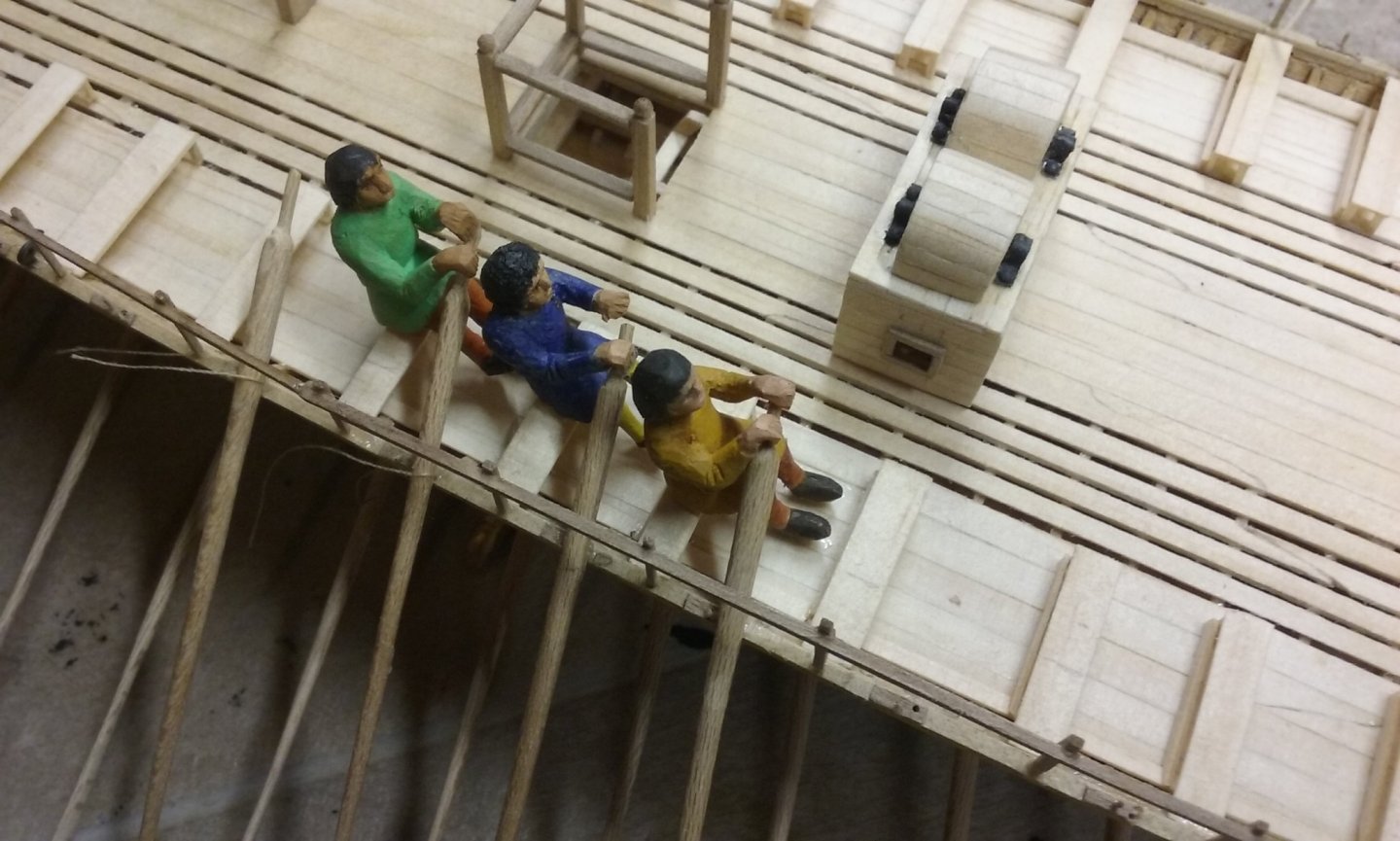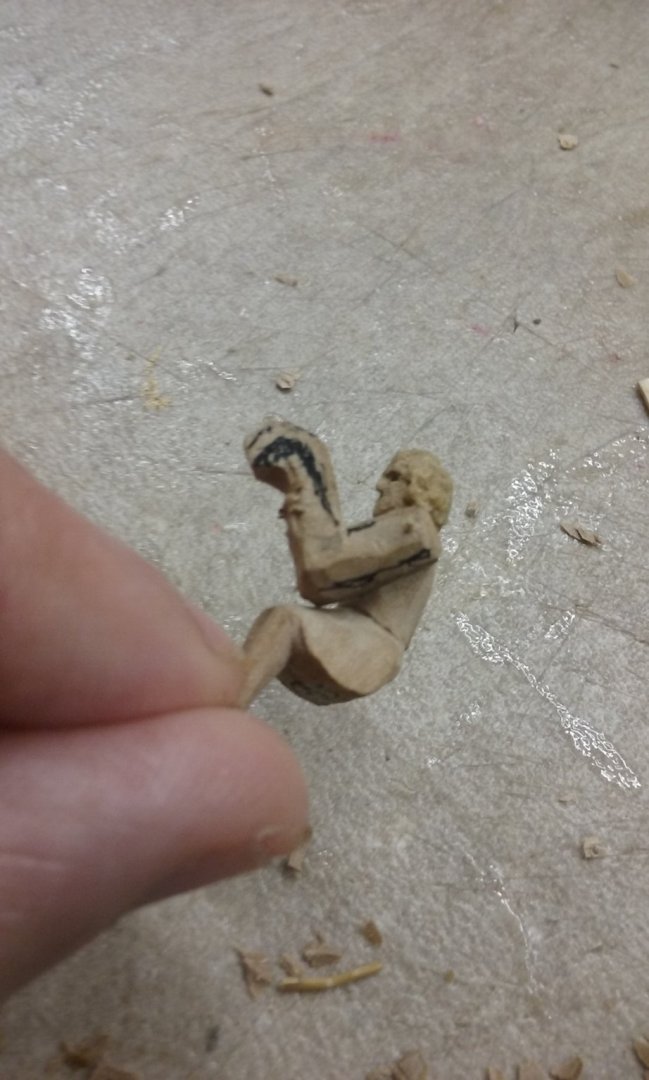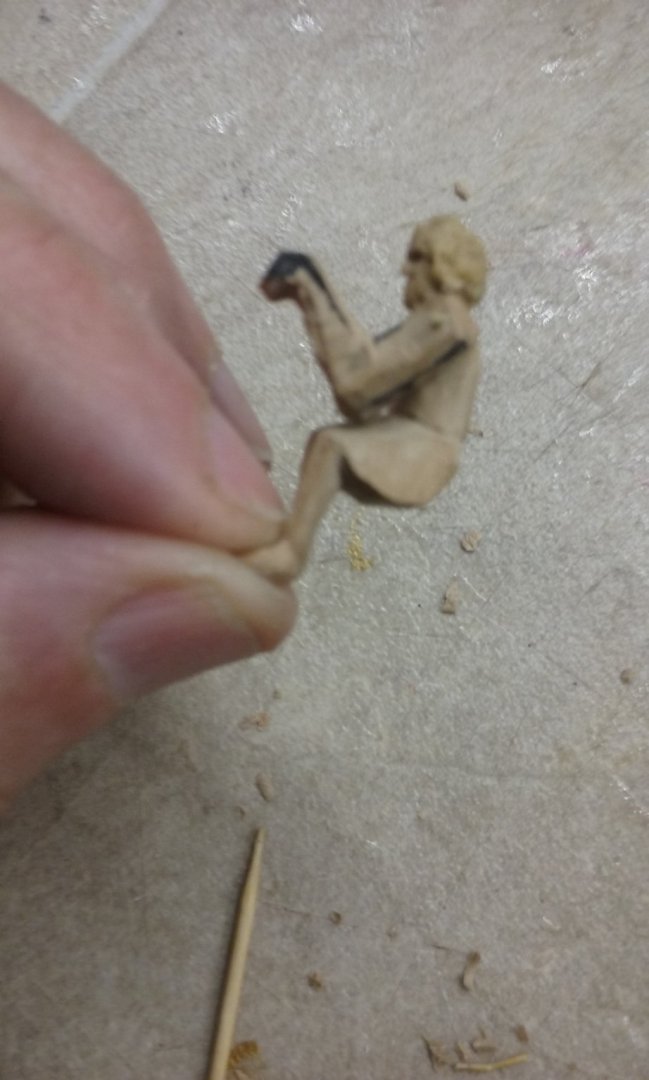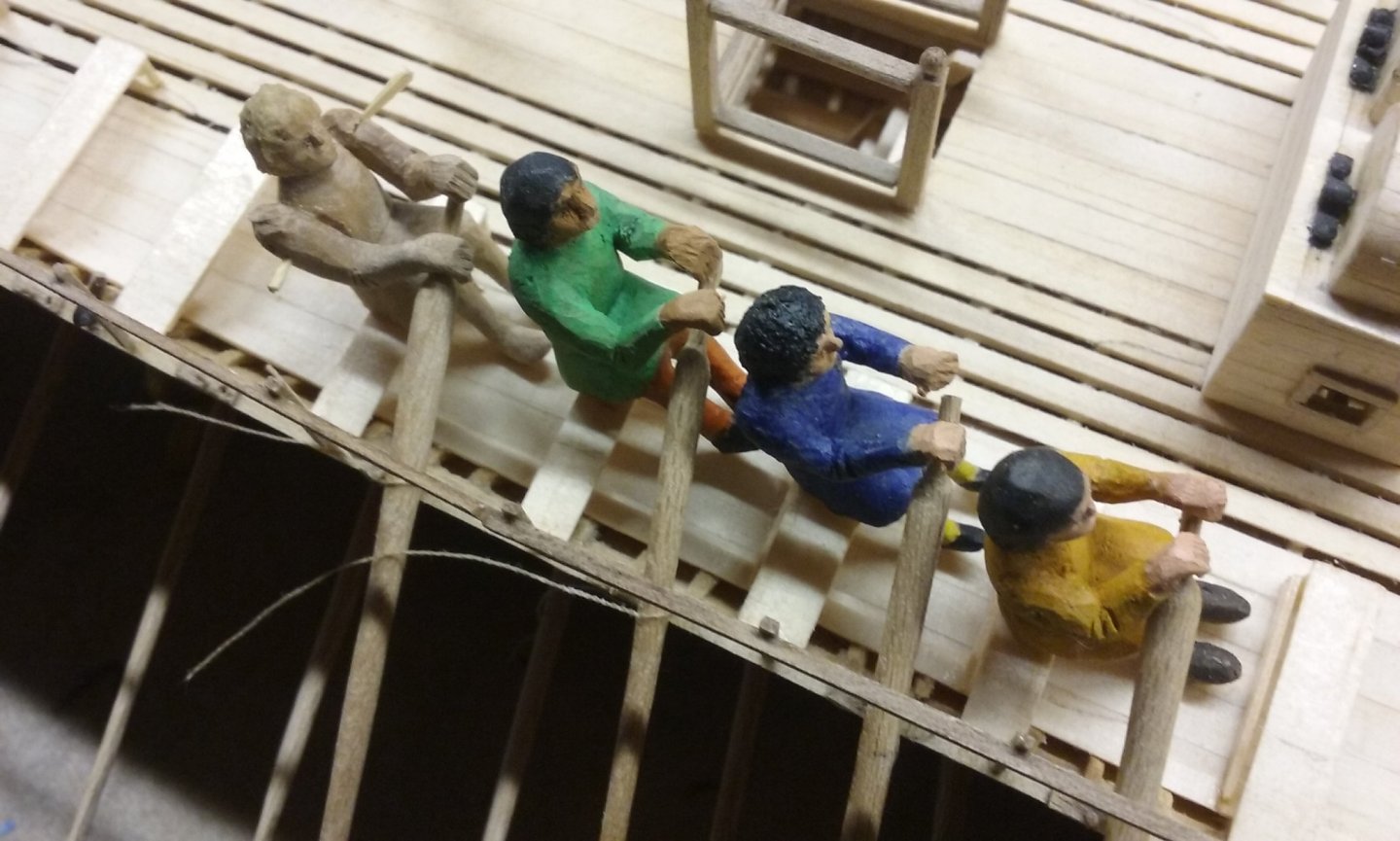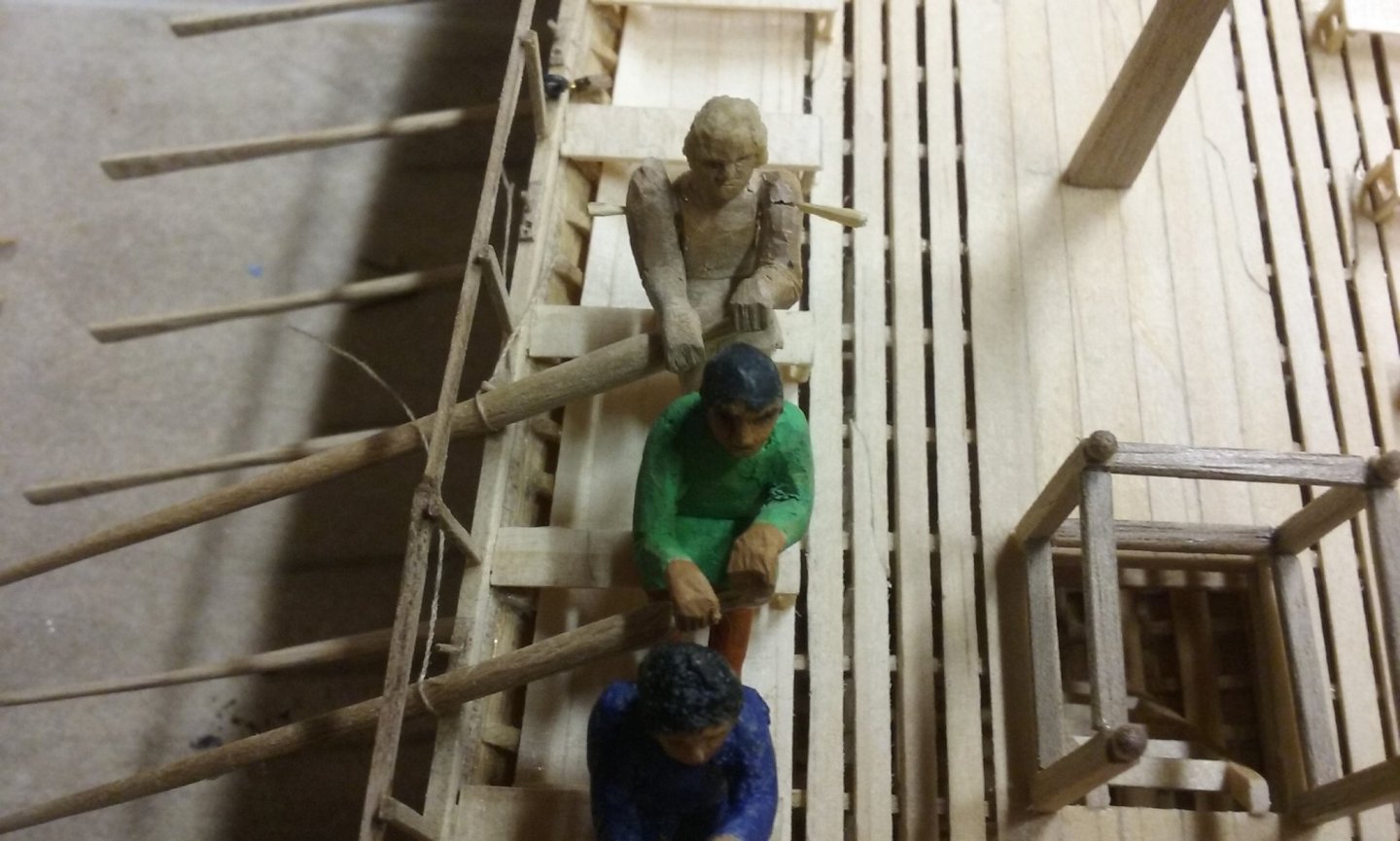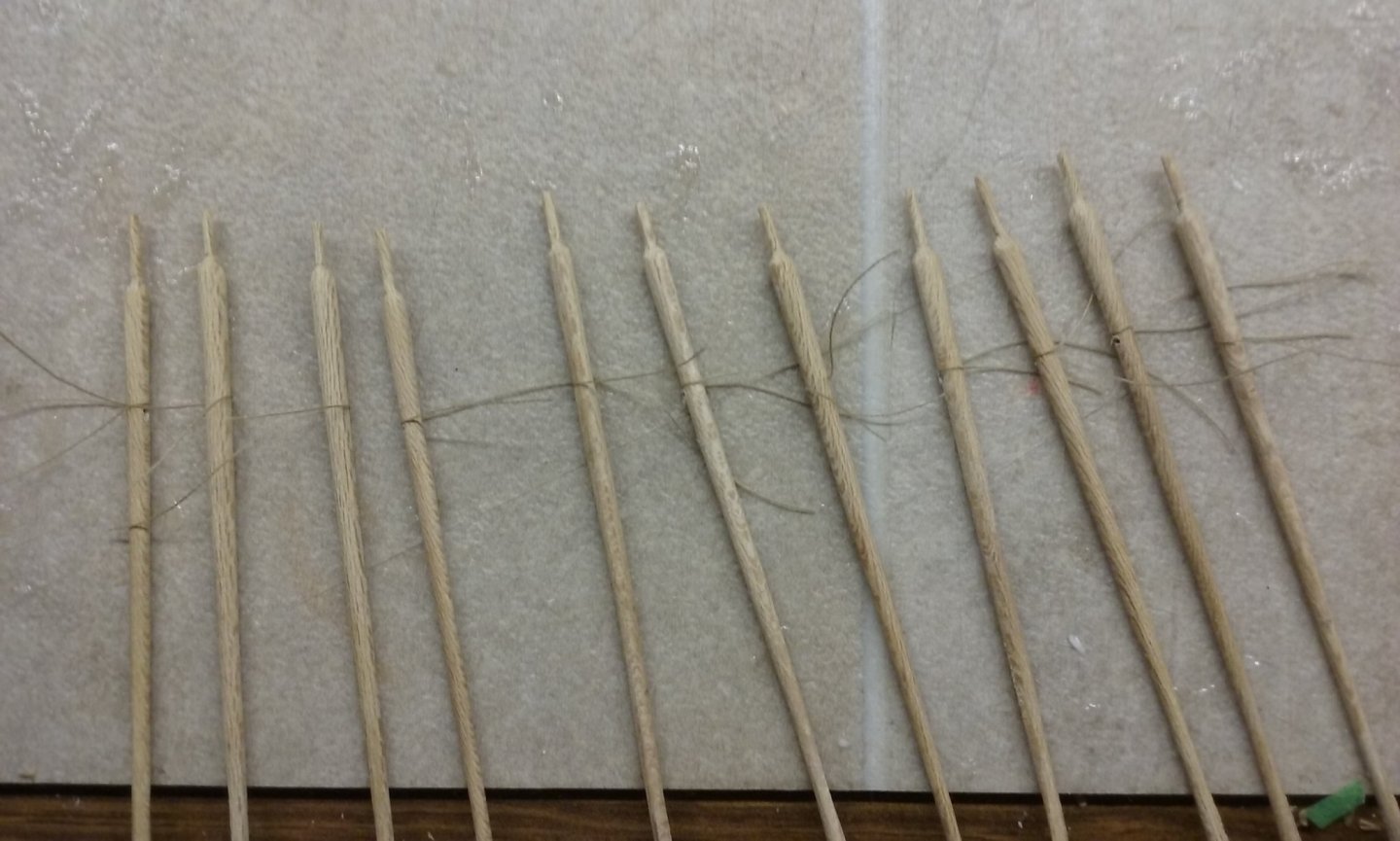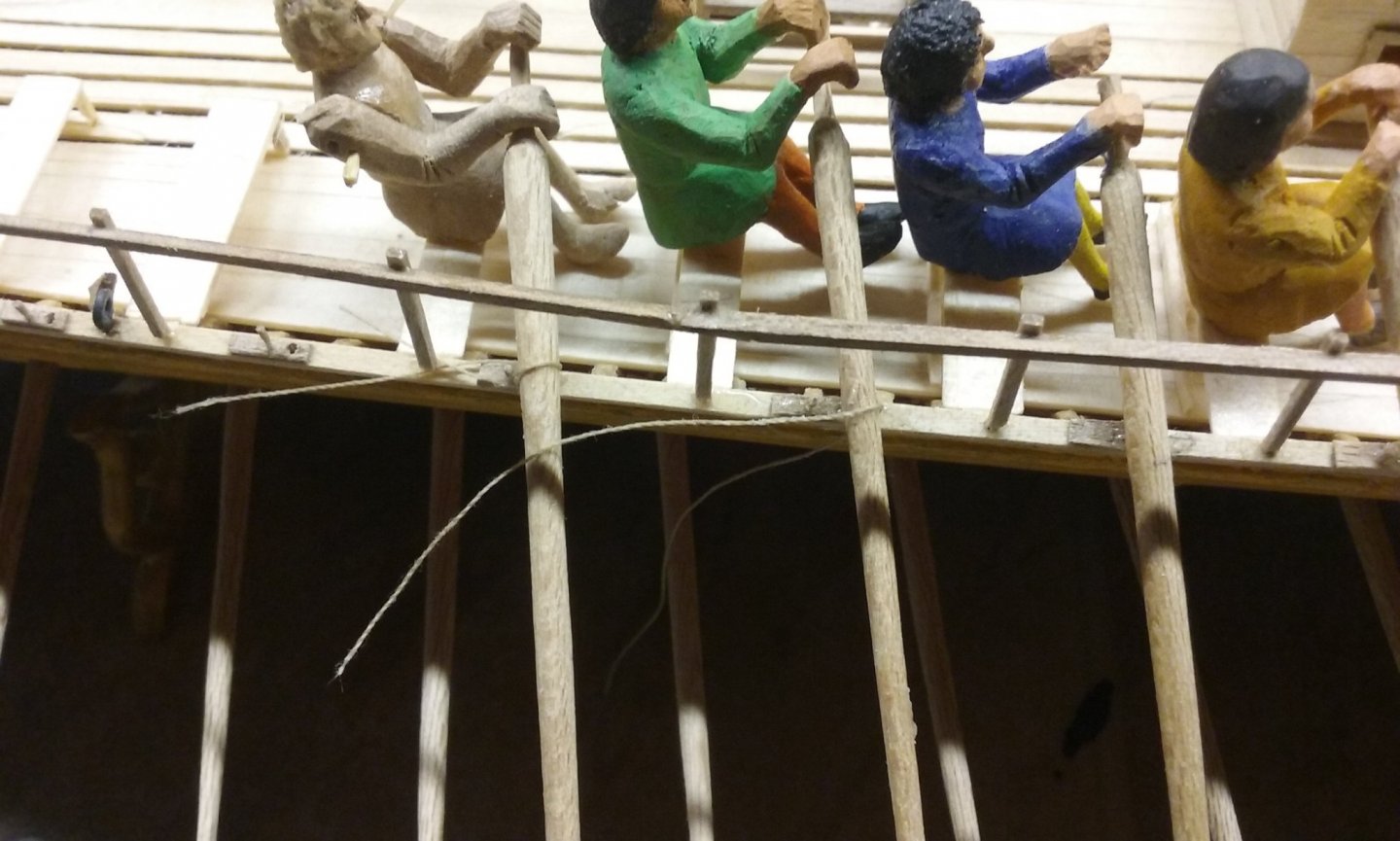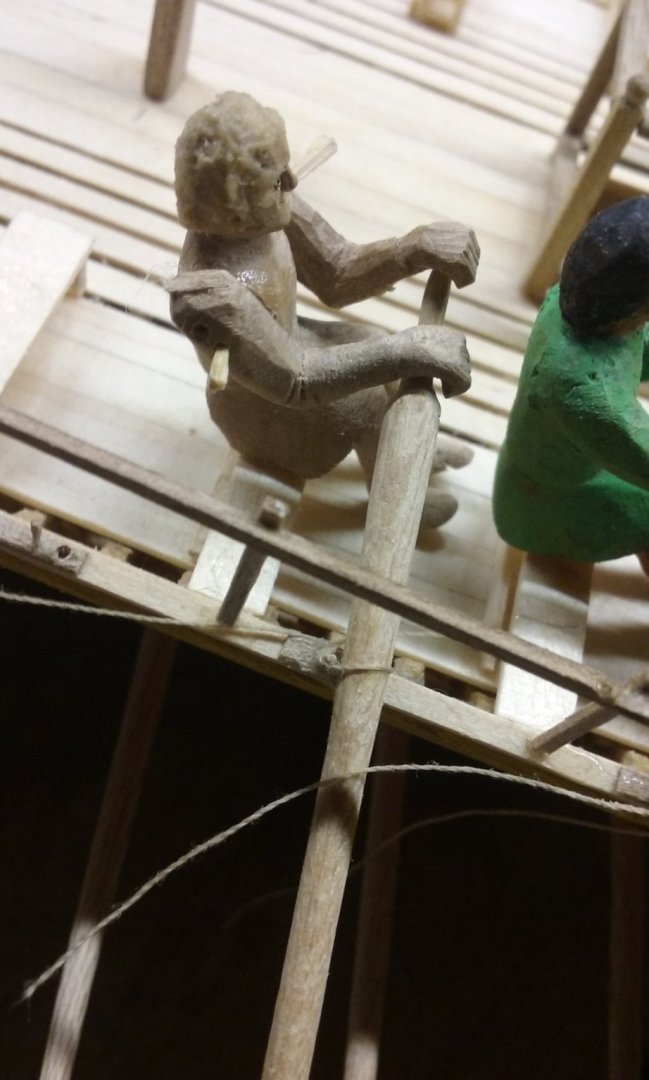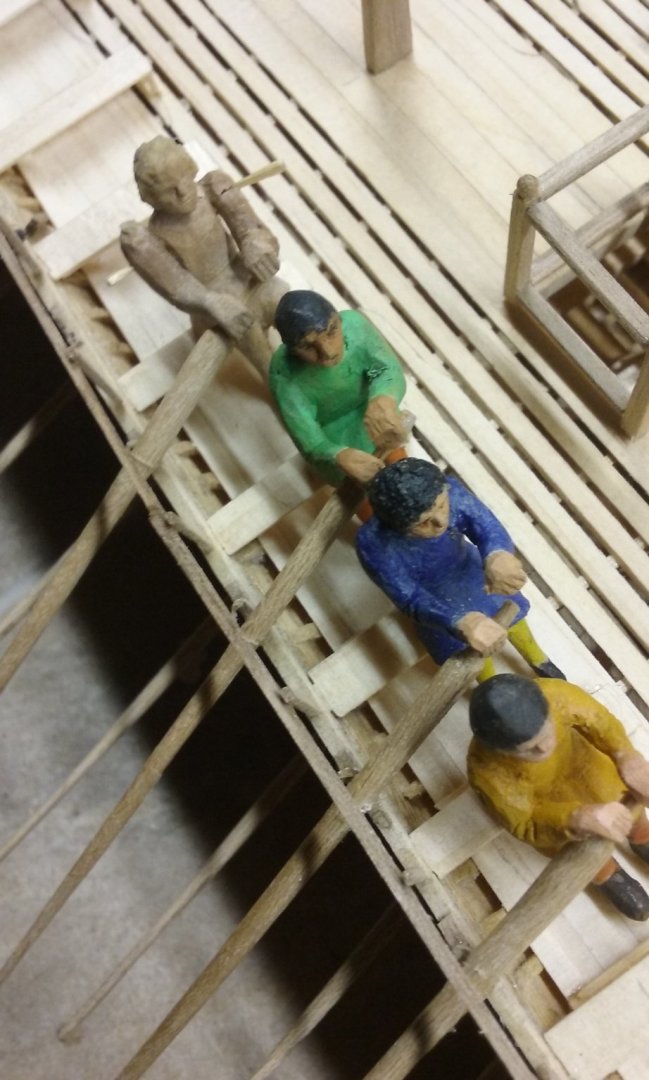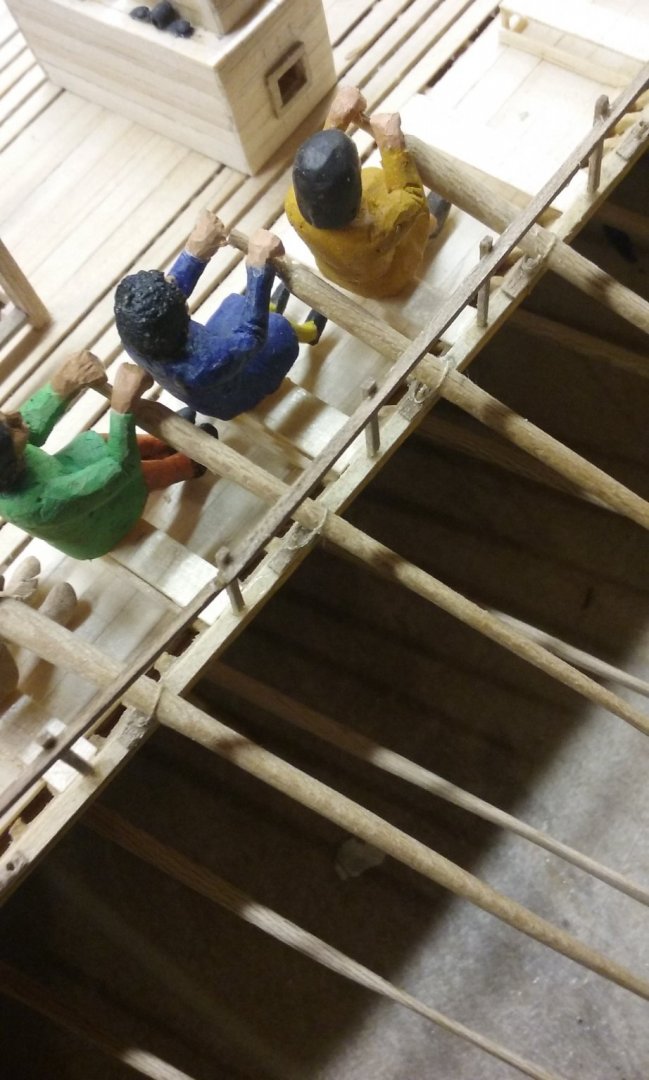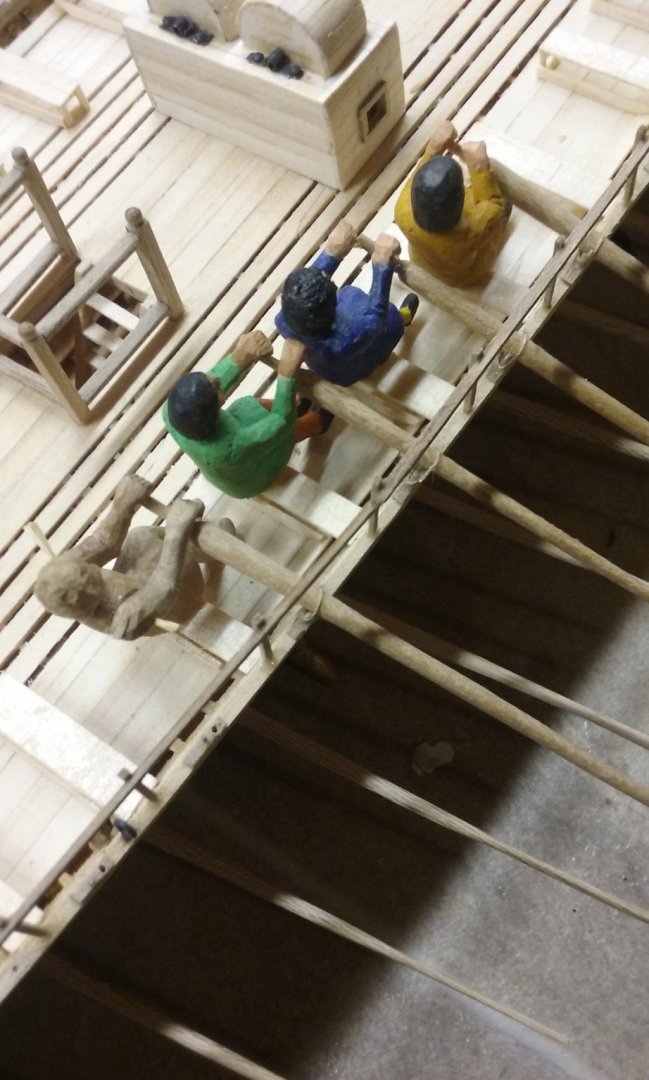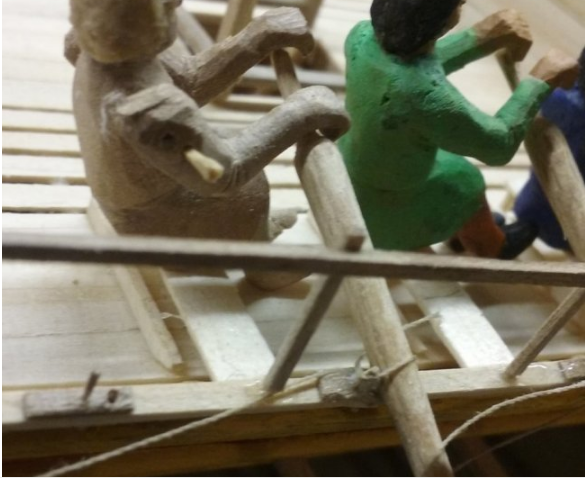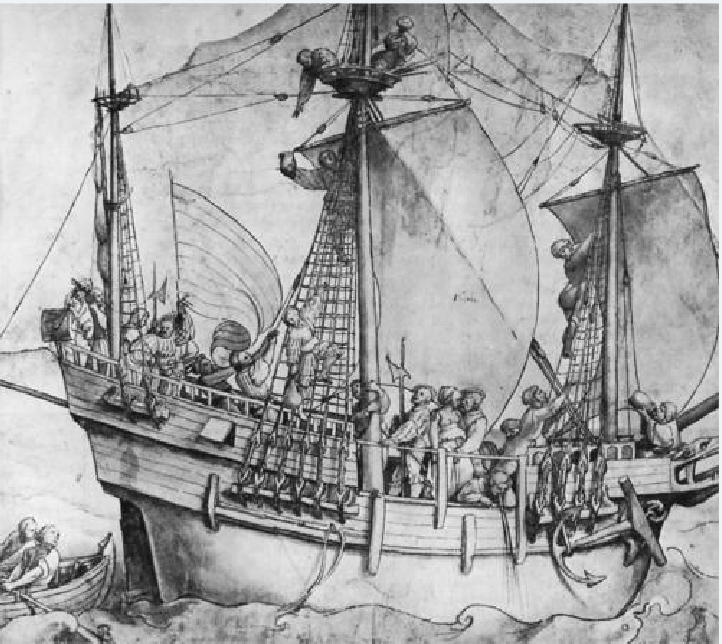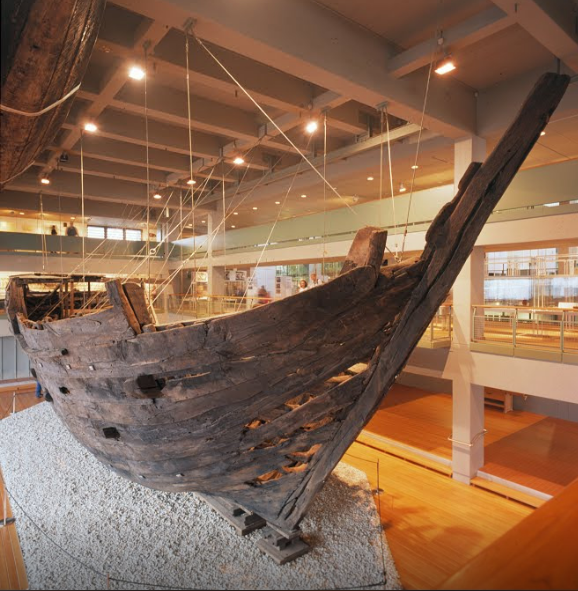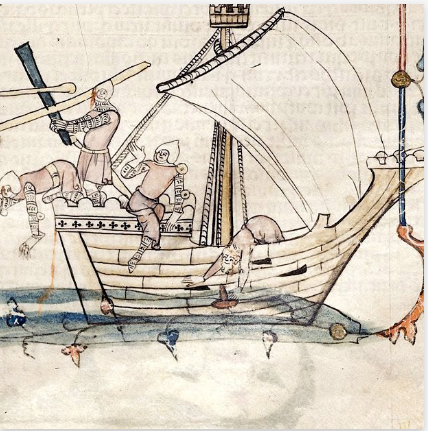-
Posts
7,986 -
Joined
-
Last visited
Content Type
Profiles
Forums
Gallery
Events
Everything posted by Louie da fly
-
Well, I said it's not a model unless you've bled on it . . . But this time I didn't cut myself with a scalpel blade while carving. Oh, no - I got much more inventive with self-harm. This time I was drilling a hole through the newly carved arm and into the shoulder so I could insert a pivot to join the two together. Unfortunately I drilled a little too far and into the finger that was behind the shoulder . . . Here's the figure with the first arm and pivot in place and here he is with the bloodstain, and the band-aided finger beside it. And finally, with his new arms, all painted and in place. The loose bits of cotton are for the oar-loops - photos further down the page. Here's the fourth oarsman with left arm partly carved and marked for reduction, then carved to that mark: Still more carving to be done to get it looking like an actual arm . . . but here he is with one arm carved to shape and glued in place - the other arm is temporarily positioned, ready for trimming to final shape. First oar-loop part done. Oar-loops around the first two oars (far left) And around the thole. And first, second and third oar-loops completed and trimmed off: I now have both arms of the most recent (unpainted) oarsman carved to shape and glued in place. Next I have to take him back off his seat, add filler where the arms meet the body and carve to final shape. Note in the first of the above three photos how much better this last oarsman's hands are than on the first guy I did (in blue), whose right hand not only has its fingers pointing the wrong way, but isn't even in contact with the oar handle. I might fix that later down the track, or just leave it as evidence of my improvement. I've also drilled the holes in all the upper oars, to take the little brass pins that will keep them in place on the gunwale, plus added cotton for the oarloops. You can only see a couple of the holes because most of the oars are turned the other way. However, after I did the first few oar-loops I decided to take the cotton back off again and glue it on each oar after it is in place - it works better that way.
-
By the way, you might be interested in this: - https://modelshipworld.com/topic/24868-topdrawings-uss-missouri/
-
EARLY SHIPS AND SEAFARING - European Water Transport Author: Professor Sean McGrail Year: 2014 Publisher: Sword and Pen Books Ltd, Barnsley UK ISBN: 978 1 78159 392 9 Pages: 183 pages plus index An interesting book which traces the evolution of vessels from the most primitive to the Middle Ages. It takes a particularly archaeological viewpoint, with an emphasis on construction techniques which though very interesting, is of limited use to the ship modeller (except those really into it - to whom I doff my hat) when what we want to know is what did they look like? What were their lines? How did the rig work? Where were the belaying points? (All right, maybe that's asking a bit much . . .) It covers maritime theory at some length - flotation, propulsion - a little offputting so early in the book, but worthy of careful study. The author deals with two separate regions - the Mediterranean, and Northern Europe - both in the descriptions of the vessels of the time and - very interestingly - the sailing conditions; coastal configuration, weather patterns, currents, prevailing winds etc - which affected both the design of the ships and how they operated - for example why the sailing routes in the Mediterranean tended to be among the islands and coast of the north - they would avoid North Africa because it was a lee shore and almost devoid of landmarks to locate one's position. Pictures are black and white, and one could wish for more of them. Though the book deals very comprehensively with Northern Europe from earliest times to the late 14th century, despite foreshadowing it in the Foreword it doesn't do the same for the Mediterranean. It stops short in Late Roman times and though it covers a few wrecks, misses opportunities it should have taken. Where are the Byzantine period ships? The book was published in 2014 but makes no mention at all of the exciting Byzantine finds from Yenikapi of 2006. Not even the Serce Limani "Glass Wreck" discovered in the 1970s. And no 14th century Mediterranean ships such as the Contarina wreck. It also gives very little attention to the pictorial record - it's very much an archaeological approach, as I mentioned above. I think in this it misses some good opportunities for theoretical reconstructions. All in all, a bit of a "curate's egg" - some parts of it are excellent. Worth a read and it certainly contained information I'm glad of. But it could have been so much better.
-
By the way, you might be interested in this: - https://modelshipworld.com/topic/24868-topdrawings-uss-missouri/
-
Damn! Why didn't I think of styrene? Very nice carvings, mate. I like your technique. I always start with the face for the reasons described on the previous page, but if this works for you (and it obviously does) go for it! And I've found as one gets more experience, the faces get better and better.
- 2,696 replies
-
- heller
- soleil royal
-
(and 9 more)
Tagged with:
-

kit review Kit Review - HMS ENTERPRIZE (1774) by CAF MODELS
Louie da fly replied to kljang's topic in REVIEWS: Model kits
Looks very good. -
Hmm, I can't see the picture. Doesn't work for me. [Edit] Now it does . . .[/Edit]
- 71 replies
-
- great harry
- henry grace a dieu
-
(and 3 more)
Tagged with:
-
It looks like it's going 90 mph just sitting there!
- 51 replies
-
- miss unlimited
- dumas
-
(and 1 more)
Tagged with:
-

Sea Witch 1846 by Zooker - RESTORATION
Louie da fly replied to Zooker's topic in - Build logs for subjects built 1801 - 1850
Hi Zooker, It's a bit of a judgment call. If the rigging and spars are intact, you're probably best to leave them in place. However, anything damaged or messed up is likely to cause you trouble if you do a half-a*sed job of it - in that case it's probably better to strip the damaged stuff down to "square one" to give yourself a free hand with repair - but keep it, and everything that can be put back in place should be - once you've repaired what you need to. I've been restoring the model I made of the Henry Grace a Dieu back when I was a teenager. What I've had to do is far more drastic than what you're up against. I had to strip mine right down. But I kept everything I possibly could and put it back in place whenever possible. I only made new stuff when I absolutely had to, and that includes the rigging. As I said, it's a judgment call. I'd say remove as little as you absolutely have to, but don't hold back if it's really necessary. Trying to fix things on deck by reaching past broken spars and tangled rigging is giving yourself a much more difficult job than you need. This is only my own opinion, and I'd hate to send you off on the wrong track. Perhaps more experienced modellers can weigh in with their own advice. Best wishes with the restoration. Take your time, and put photos up as you go, so others can help with tips and advice. And do start a build log. Though I know you haven't actually taken your first step in restoration, this discussion is past the point where belongs in "New Member Introductions" - it should be in a build log, so others can see it and add helpful suggestions. -
Interesting difference - certainly neither of them are correct with the shrouds passing outside the top. - it would go against all normal practice. Looking at contemporary art, the pictures of the Great Harry in the Anthony Roll and the Embarkation at Dover both show them terminating at the top as you'd expect, but the first doesn't show deadeyes even on the lower shrouds, and the second only shows the lower row of deadeyes for the main shrouds, not the lanyards or the upper row of deadeyes. As far as I can see neither of these are to be relied on, and that goes for almost all contemporary art - they just don't bother to show deadeyes at all.) One exception is a galleon from 1533 by Holbein, which shows them beautifully on the lower shrouds, but not on the topmast ones. What you do about it is another question - yes, it seems incorrect, but if that's the way the model was originally made, perhaps it's best to duplicate it, mistakes and all. I agree, but regarding the number of shrouds and deadeyes, perhaps it would be best to go with what you've got if you can't see any evidence that the other two were ever there. It might just be that one model was made with 5 shrouds per side and the other with 7. The MAAS model does seem a little more sophisticated than the one you have, and may have included more detail right from the start. One last thing - would it be possible to post some photos of the model as it was originally received? I know you have it in a thread in another section of MSW, but it would be good to have the original condition photos to compare with the restoration as it progresses.
- 71 replies
-
- great harry
- henry grace a dieu
-
(and 3 more)
Tagged with:
-

Sea Witch 1846 by Zooker - RESTORATION
Louie da fly replied to Zooker's topic in - Build logs for subjects built 1801 - 1850
Thanks, Zooker. The uprights seem to be relatively ok - it seems to be just the railing itself that is missing or damaged. It seems to have been just glued on top of the uprights, and could probably be replaced with a similar piece of wood, after you've cleaned any excess paint, glue etc from the uprights, and the dirt from the top of the middle rail. That's for that part of the ship. But I'd suggest a very systematic approach to the whole vessel. In my view you'd be best to keep everything you possibly can of the original model and only replace with new when you have to. Repair rather than replace. First, take LOTS of photos, from every conceivable angle, to record how everything is fixed to everything else in its current state. Where each rope goes, what it's fixed to and how etc etc, particularly where damage has occurred. Then, gently and systematically remove damaged parts, ropes etc, keeping track of what belongs where. Perhaps put the ropes, spars etc for each particular mast in its own box or envelope. Some ropes go between two masts - that's a matter for judgment - gently unfix it from one end and keep it attached to the other. Depending on the type of glue was used on the model you have various options to remove it - white glue (PVA) succumbs to rubbing alcohol (isopropyl alcohol or isopropanol), and I'm told CA (superglue) dissolves in nailpolish remover. Try it out on a relatively unseen part and see what results you get. Once all the damaged stuff is removed, what you have left is the hull and the parts that are in good condition, and you're free to start cleaning up. Apparently the best method of cleaning (which is what museum restorers use) is cotton buds (Q-tips) and saliva, replacing the buds as they get dirty. After everything's clean, you can start in on the repairs. What I wouldn't recommend is to (say) glue a broken mast together while it's still got all the ropes attached - at least not have ropes running from the broken mast to somewhere else. They'll impose uneven forces on the spar and it's almost certain to mend crooked. Work on relatively minor parts that aren't glaringly obvious firstly, so if you make a mistake it doesn't show too much. As you gain experience and confidence, move to the more major items. Oh, and often when a mistake occurs (and they will), it's possible to undo it and do over properly. Just take it methodically and don't hurry. One good repair is worth any number of rushed, half-done ones. Eventually it will start looking like a ship. And in the long run you'll have something you'll be proud to put in a display cabinet and show to your admiring friends. Good luck, and have fun with it! -
That makes a lot of sense, Chuck. Without a sense of scale it does appear that the planks are short in comparison to their width, but apparently it's the other way around. (And with planks that wide there would be serious spiling problems if they were any longer.)
- 179 replies
-
- shipyard
- wütender hund
-
(and 1 more)
Tagged with:
-
Oh, that's just magnificent! It just keeps getting better!
- 51 replies
-
- miss unlimited
- dumas
-
(and 1 more)
Tagged with:
-
It's wonderful to see such a painstaking restoration. Thumbs up.
- 71 replies
-
- great harry
- henry grace a dieu
-
(and 3 more)
Tagged with:
-
Welcome to MSW, Wayne! I can't help with card models - never made one - but the link above should be of great help (Chris is far too modest ).
-
Dunno the answer to that one, either. I know virtually nothing about the construction details of cogs other than what I have learned from working on this kit. Upper works on a wreck are usually the first things to be lost, unless the wreck happens to be lying in a position/inclination that preserves them for us. The Ijsselcog seems to have had had none surviving https://www.academia.edu/40371597/The_IJsselcog_project_from_excavation_to_3D_reconstruction and the Bremen cog also seems to have lost a lot of its upper works - https://www.ipi.uni-hannover.de/fileadmin/ipi/publications/wiggenhagen_04_istanbul.pdf But if we compare the two pictures below (from https://artsandculture.google.com/exhibit/the-so-called-bremen-cog/owKSqVwIBfJGJw ) it looks like the hooked timber for the anchor is still in place, so the top strake must be as well - in which case there seems to have been no cap rail. One thing that really gets me is how short the strakes seem to have been. I wonder if there was a reason for it? Sorry to hear about the speed bump, Chris, but the model is looking very good.
- 179 replies
-
- shipyard
- wütender hund
-
(and 1 more)
Tagged with:
-

Sea Witch 1846 by Zooker - RESTORATION
Louie da fly replied to Zooker's topic in - Build logs for subjects built 1801 - 1850
It's a bit hard to tell from the photos how that railing is made. Is it cast plastic or made out of individual pieces of wood? Can you provide some close-ups with better detail? -

Sea Witch 1846 by Zooker - RESTORATION
Louie da fly replied to Zooker's topic in - Build logs for subjects built 1801 - 1850
Zooker, this could be a very rewarding build, but I'd agree - take your time, record everything as you go, and don't rush into it. You might like to look at the build log for the Great Harry (Henry Grace a Dieu) that the Central Ohio Shipwrights are doing - In my opinion they're doing a very good job, taking their time, cleaning and tidying to a point where they're starting with what amounts to a clean slate, rather than "find a problem - correct it, find another problem - correct it", which can get very messy. But they've done their research, recorded everything and worked out what to do before rushing in (something I'm sorry to say is one of my own faults). To get this model back to its former glory you need to be methodical, step by step. And do some reading on the rigging of this kind of ship so you know what you're aiming at. It's likely to be a big job, but with patience and care you'll end up with something to be really proud of, and a good memorial to your uncle. Oh, and nearly forgot - "PM" = Private message - click on the ikon of two "speech bubbles" at the top right hand side of the page. And if there's a message waiting for you there's normally a white number in a red square (from memory) to let you know. -
That's good news. I think you're on the right track using that as a source, as it reflects the state of knowledge about the time the model was built. Yes, that's one of my "go-to" sources with ships of this period. And as far as I know, none exists. There are some contemporary paintings that show rigging, but I have grave doubts about the maritime knowledge of the artist (for example on the Embarkation at Dover, the mizzen masts have square sails!) Thanks very much for those beautifully clear, detailed photos. It gives a very good idea of the job you have ahead of you. In my opinion your strategy in repairing the model is exactly right.
- 71 replies
-
- great harry
- henry grace a dieu
-
(and 3 more)
Tagged with:
-
A beautiful job, Jamie. You've got good reason to feel proud of it. Looking forward to your next build . . .
- 41 replies
-
- thermopylae
- scientific models
-
(and 3 more)
Tagged with:
-
Thanks for all the likes. Jamie, thanks for the comment. I have to admit I found myself trapped into doing it to a certain degree - If I hadn't carved the other figures (Emperor and his court etc) I wouldn't have felt obliged to carve the oarsmen. A lot more work than I'd anticipated, but now I have the position of the arms under control it's becom enjoyable again instead of a trial. Carl, yes that's what i was thinking. I have thread of different thicknesses, and if my "tan" sewing cotton is too thin I'll be dyeing one of the thicker ones to a worthwhile shade for the strap/loop..
-
That planking has come up magnificently! And the stand is worthy of the model.
- 51 replies
-
- miss unlimited
- dumas
-
(and 1 more)
Tagged with:
-
So many ropes! (That's one reason why I stay away from later vessels. So much simpler in the middle ages!)
- 41 replies
-
- thermopylae
- scientific models
-
(and 3 more)
Tagged with:
-
That seems to be the way of it, B-Ram. Apparently the model kit companies are experiencing unprecedented demand - it's probably not how they wanted to increase their profits, but . . . Perhaps you can order it on-line if you can't get it any other way. Unfortunately getting rid of flashing is one of the inevitable issues in plastic modelling. But as with all things, there comes a time when it's all done and you can move on to more interesting things.
About us
Modelshipworld - Advancing Ship Modeling through Research
SSL Secured
Your security is important for us so this Website is SSL-Secured
NRG Mailing Address
Nautical Research Guild
237 South Lincoln Street
Westmont IL, 60559-1917
Model Ship World ® and the MSW logo are Registered Trademarks, and belong to the Nautical Research Guild (United States Patent and Trademark Office: No. 6,929,264 & No. 6,929,274, registered Dec. 20, 2022)
Helpful Links
About the NRG
If you enjoy building ship models that are historically accurate as well as beautiful, then The Nautical Research Guild (NRG) is just right for you.
The Guild is a non-profit educational organization whose mission is to “Advance Ship Modeling Through Research”. We provide support to our members in their efforts to raise the quality of their model ships.
The Nautical Research Guild has published our world-renowned quarterly magazine, The Nautical Research Journal, since 1955. The pages of the Journal are full of articles by accomplished ship modelers who show you how they create those exquisite details on their models, and by maritime historians who show you the correct details to build. The Journal is available in both print and digital editions. Go to the NRG web site (www.thenrg.org) to download a complimentary digital copy of the Journal. The NRG also publishes plan sets, books and compilations of back issues of the Journal and the former Ships in Scale and Model Ship Builder magazines.


